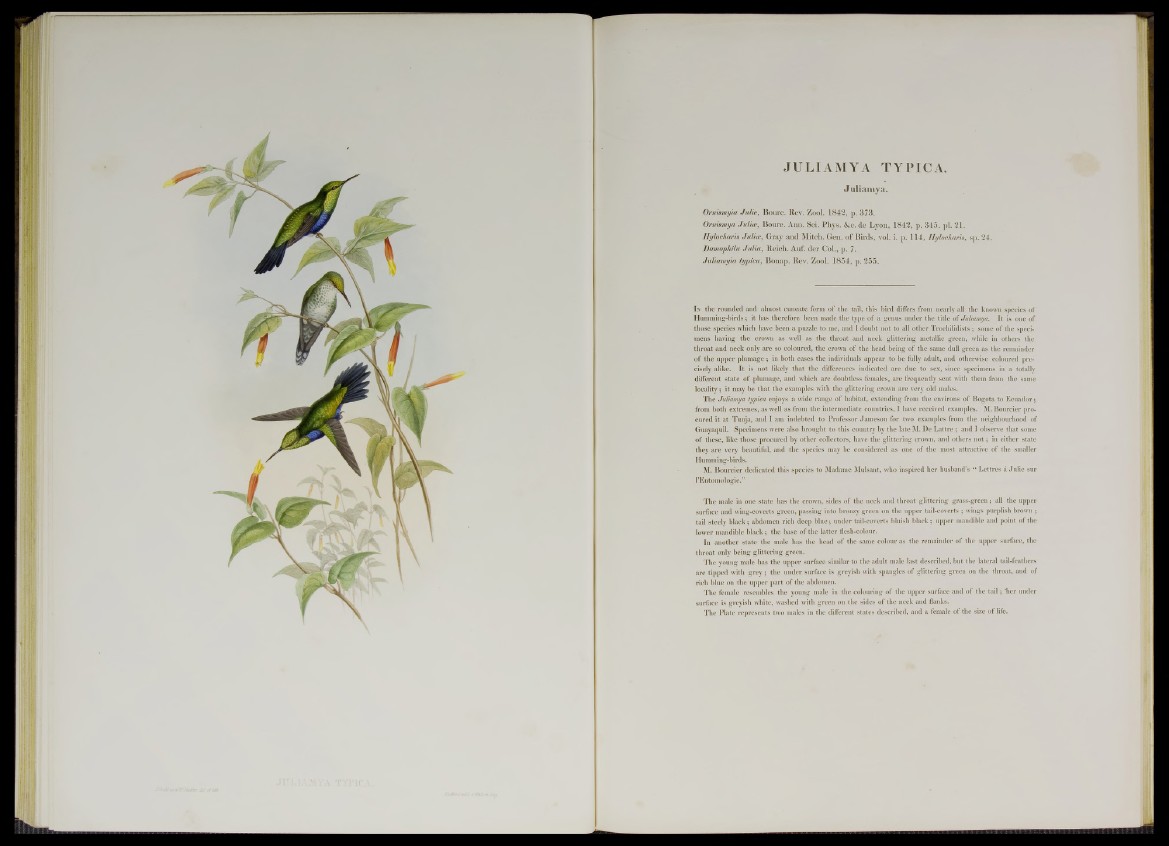
JULIAMYA TYPICA.
J uliamya.
Ornismyia Julie, Bourc. Rev. Zool. 1842, p. 373.
Omismya Ju lia , Bourc. Ann. Sci. Phys. &c. de Lyon, 1842, p. 345. pi. 21.
Hylocharis Ju lia , Gray and Mitch. Gen. o f Birds, vol. i. p. 114, Hylocham, sp. 24.
Damophila Julia, Reich. Auf. der Col., p. 7.
Juliamyia typica, Bonap. Rev. Zool. 1854, p. 255.
I n the rounded and almost cuneate form of the tail, this bird differs from nearly all the known species of
Humming-birds; it has therefore been made the type of a genus under the title of Juliamya. It is one of
those species which have been a puzzle to me, and I doubt not to all other Trochilidists ; some of the specimens
having the crown as well as the throat and neck glittering metallic green, while in others the
throat and neck only are so coloured, the crown of the head being of the same dull green as the remainder
of the upper plumage ; in both cases the individuals appear to be fully adult, and otherwise coloured precisely
alike. It is not likely that the differences indicated are due to sex, since specimens in a totally
different state of plumage, and which are doubtless females, are frequently sent with them from the same
locality; it may be that the examples with the glittering crown are very old males.
The Juliamya typica enjoys a wide range of habitat, extending from the environs of Bogota to Ecuador;
from both extremes, as well as from the intermediate countries, I have received examples. M. Bourcier procured
it at Tunja, and I am indebted to Professor Jameson for two examples from the neighbourhood of
Guayaquil. Specimens were also brought to this country by the late M. De Lattre ; and I observe that some
of these, like those procured by other collectors, have the glittering crown, and others n o t; in either state
they are very beautiful, and the species may be considered as one of the most attractive of the smaller
Humming-birds.
M. Bourcier dedicated this species to Madame Mulsant, who inspired her husband’s “ Lettres a Julie sur
l’Entomologie.”
The male in one state has the crown, sides of the neck and throat glittering grass-green; all the upper
surface and wing-coverts green, passing into bronzy green on the upper tail-coverts ; wings purplish brown ;
tail steely black; abdomen rich deep blue; under tail-coverts bluish black; upper mandible and point of the
lower mandible black; the base of the latter flesh-colonr.
In another state the male has the head of the same colour as the remainder of the upper surface, the
throat only being glittering green.
The young male has the upper surface similar to the adult male last described, but the lateral tail-feathers
are tipped with grey; the under surface is greyish with spangles of glittering green on the throat, and of
rich blue on the upper part of the abdomen.
The female resembles the young male in the colouring of the upper surface and of the ta il; 'her under
surface is greyish white, washed with green on the sides of the neck and flanks.
The Plate represents two males in the different states described, and a female of the size of life.